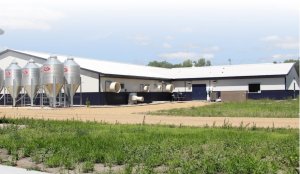As with any institution, the South Dakota State Legislature has its own traditions, procedures, and jargon. Many are common to other state legislative bodies. Unique to South Dakota, though, is the “hoghouse.”

Originally a colloquialism, the “hoghouse amendment” is referred to specifically in the South Dakota State Legislature’s rules, which define it as “a substitute bill” that “shall be treated as an amendment and shall be governed by the rules governing amendments.” In short, a hoghouse amendment strikes the entire language of a bill and replaces it with a different bill.
It is the received wisdom of legislative observers that the “hoghouse” term has its roots in legislation relating to the construction of a new hog facility near Brookings for what at that time was South Dakota State College. The details of the story, however, vary.
Below is the best account of the term’s origin that I have seen. This account was written in 1997 by Mark Zickrick of the Bureau of Finance and Management; it was shared with me by Robert Frieberg, a Beresford attorney and former legal counsel to the University of South Dakota:
The following is pieced together from an article in the March 5, 1921 Daily Capital Journal (p. 2) headlined “Hog House Bill Vehicle for Law Makers Extra Pay,” the 1921 House and Senate Journals, and the 1921 Session Laws.
In 1921, Senate Bill 342 was introduced on February 23 to appropriate $10,000 “for buildings and improvements on the college farm to be used for hog houses, poultry houses, horse barns, fences, etc.” It passed the Senate on February 25 and went to the House.
House Bill 231, a bill to appropriate $29,000 for legislators’ living expenses for that session was introduced on February 10, passed the House on the 14th, the Senate on the 24th, and was delivered to the Governor [William H. McMaster] on Friday the 25th. HB 231 was apparently pretty controversial. Questions raised had to do with the constitutionality of the legislature paying itself living expenses, especially for that session, and the Attorney General told legislators it “would not hold water.” The Governor let it take effect, though, without signature by not returning it to the house of origin within the prescribed time. SB 231, therefore, was law about a week before session ended.
In those days sessions were 60 days but biennial. The 60th Day was March 4.
On March 4, SB 342 was up for its final consideration in the House. It failed. They amended it with extreme prejudice, and then they recessed. It’s 4:10 on Friday afternoon. It’s the 60th Day. The new version of SB 342 looked a lot like HB 231 which, as you’ll remember, was already law. However, there were two interesting differences: HB 231 referred to legislators living at “the State Capital,” and SB 342 Amended said “State Capitol;” also, HB 231 was not an emergency bill, it just said the “funds appropriated are available at the close of the present legislative session” and SB 342 declared an emergency.
Anyway, SB 342 was sent back to the Senate for concurrence, but things were pretty kinky if you ask me (and as the journals imply). The House recessed at 4:10 pm, just after passing SB 342, and reconvened “Pursuant to motion” at 4:20 pm. I don’t think so. One of the next items of business is the report from the Committee on Engrossed and Enrolled Bills that a bunch of bills had been delivered to the Governor at 9:30 pm. SB 342 had been amended by the House, you know, and sent back to the Senate for concurrence.
Just after the House reconvened at “4:20 pm,” the Speaker of the House signed SB 342 with its original title, “An Act Appropriating Money for Improvements on the College Farm at Brookings, South Dakota.” That despite there having been a title amendment made right after the bill had been amended and passed, and right before they recessed at 4:10 pm.
Meanwhile, the Senate had just reconvened at 4 pm. They did some housekeeping, then some conference committee reports, then heard the Message from the House about SB 342’s revision. The first item of business was to concur soundly, then they did a couple of more bills, some housekeeping, and recessed at 5:20 pm.
No more is heard of SB 342, except that it was delivered to the Governor “at 11:50 pm” under a title that refers to legislative living expenses. HB 231 got recorded into Session Laws.
So, the Original “Hog House Bill” was 1921’s SB 342, a bill to appropriate money for various improvements at State College. It passed the Senate and was gutted in the House before being sent off to oblivion. I assume it was vetoed, but there is no record of such, except that it doesn’t appear in the Session Laws for that year.
This blogger can supplement Zickrick’s research in one particular. The March 17, 1921 Brookings Register reported in a Page 1 article headlined, “Hog House Bill Falls Under Ax: Governor McMaster Vetoes Expense Allowance for Legislators.” The article continued:
The bill for $200 expense money for members of the legislature is a measure which was passed at the last moment, through a legislative trick, to force early payment of the money authorized in an earlier bill. The attorney general advised the state auditor not to pay the expense money without a ruling from the supreme court. The law would not be effective until July. The legislature, by substituting the expense bill for the so-called “Brookings Hog House” bill on the last night, tried to force the hand of the state auditor with an emergency clause. It is this measure which McMaster killed.
